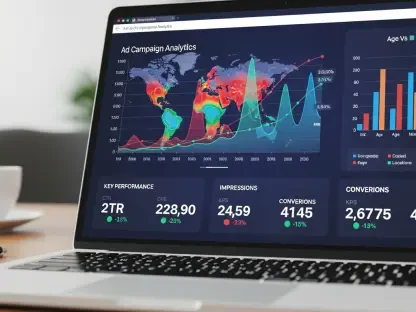Introduction to Q4 Digital Marketing Landscape
The fourth quarter, spanning October to December, stands as the pinnacle of opportunity and competition in the digital marketing realm, with consumer spending projected to hit unprecedented highs during major sales events. As Black Friday, Cyber Monday, and holiday shopping peaks drive a surge in online activity, brands find themselves in a race to capture attention amid a crowded digital space. This period is not just about sales; it represents a critical window to build lasting customer relationships through strategic engagement.
During Q4, the industry sees an intricate interplay among key players such as media buyers, brands, affiliates, and publishers, all leveraging cutting-edge technology to refine their approaches. The significance of advanced tools like AI-driven analytics cannot be overstated, as they enable precise targeting and real-time campaign adjustments. These technological advancements shape how campaigns are crafted and executed in an increasingly data-driven environment.
The importance of Q4 lies in its unique ability to capitalize on heightened consumer intent, coupled with expanded marketing budgets from brands eager to close the year strong. This quarter often dictates annual performance metrics, making it a make-or-break season for many businesses. Success hinges on understanding the seasonal dynamics and deploying strategies that resonate with purchase-ready audiences.
Emerging Trends and Opportunities in Q4 2025
Key Trends Shaping Digital Marketing Strategies
One of the defining aspects of Q4 is the emphasis on high-intent, conversion-driven campaigns across diverse platforms like search engines, social media, and inspiration hubs such as Pinterest. These channels cater to consumers who are often past the browsing stage, seeking specific deals or products. Marketers are prioritizing targeted keywords and visual storytelling to convert interest into immediate action.
Another notable shift is the rise of niche verticals tailored to seasonal demands, including home insurance, cybersecurity, gifts, and e-commerce, influenced by both consumer needs and broader economic conditions. These sectors see spikes in interest as households prepare for holidays or safeguard new purchases. Campaigns focusing on these areas often yield higher engagement due to their relevance.
Additionally, omnichannel approaches have become indispensable, integrating multiple platforms to maximize reach and interaction with diverse audience segments. Combining search for intent, social media for scale, and niche platforms for inspiration ensures a comprehensive presence. Emerging technologies, such as AI-powered targeting and sophisticated retargeting methods, further enhance performance by personalizing user experiences and re-engaging potential customers during peak shopping moments.
Market Insights and Growth Projections
Consumer behavior in Q4 reveals a distinct purchase-ready mindset, often fueled by urgency, emotional triggers around gifting, and a strong demand for value and trust in transactions. Shoppers are more discerning, seeking deals that align with their needs while prioritizing brands that demonstrate reliability. This creates a fertile ground for campaigns that emphasize transparency and emotional resonance.
Growth projections for trending verticals paint an optimistic picture, with sectors like cybersecurity anticipated to experience double-digit increases compared to the third quarter. This surge is driven by heightened concerns over data protection during holiday travel and device purchases. Other areas, such as e-commerce and gifts, also show robust upward trends, reflecting seasonal shopping fervor and early campaign launches.
Performance indicators further underscore the competitive nature of this quarter, with cost-per-mille (CPM) rates on platforms like Facebook and Instagram climbing significantly during peak periods. Despite higher costs, the return on investment remains substantial for well-timed campaigns. Looking ahead, historical data and current market dynamics suggest these trends will intensify through December, with early movers gaining a distinct advantage in capturing market share.
Challenges Facing Q4 Digital Marketing Campaigns
Navigating Q4 is not without hurdles, as partner onboarding freezes pose a significant barrier to new collaborations during this peak season. Many top-tier publishers and affiliates focus on maximizing revenue with existing partnerships, leaving latecomers struggling to secure placements. This underscores the need for strategic foresight in locking in agreements well before the rush begins.
Intensified competition and escalating advertising costs also strain campaign budgets and effectiveness, particularly on high-traffic platforms where bidding wars are common. Brands often face diminishing returns if their creatives or targeting lack precision. Smaller players, in particular, may find it challenging to compete against larger budgets, necessitating innovative, cost-effective solutions to stand out.
Last-minute planning further compounds these issues, with delayed creative assets or promo calendars risking missed opportunities during critical traffic surges. The fast-paced nature of Q4 leaves little room for error, as audiences quickly shift focus to competitors offering timely deals. To mitigate these challenges, early preparation and partnerships with experienced agencies can provide the necessary edge, ensuring campaigns launch seamlessly and capture peak interest.
Regulatory and Compliance Considerations for Q4
The regulatory landscape significantly impacts digital marketing in Q4, with data privacy laws and advertising standards shaping how campaigns are designed and delivered. Stricter guidelines around user consent and data usage require brands to adopt transparent practices, especially during a period of heightened online activity. Non-compliance can result in penalties and eroded consumer confidence, both detrimental during this high-stakes quarter.
Compliance is particularly critical in verticals like cybersecurity, where promotions must clearly communicate data protection benefits without misleading claims. Transparent messaging not only aligns with regulations but also builds trust with wary consumers. Brands must ensure that their claims are substantiated and aligned with industry standards to avoid legal repercussions.
Security measures play a dual role in regulatory adherence and consumer trust, especially during high-stakes shopping events when fraud risks spike. Robust safeguards and clear communication about data handling practices reassure users, enhancing brand credibility. Regulatory changes may also influence platform-specific strategies, requiring marketers to stay agile and adapt to evolving policies to maintain campaign momentum.
Future Outlook for Digital Marketing Beyond Q4 2025
Looking beyond the fourth quarter, digital marketing is poised to maintain momentum with omnichannel strategies and niche verticals retaining relevance into the coming years. The integration of multiple touchpoints will continue to define successful campaigns, as consumers expect seamless experiences across devices and platforms. Niche sectors that gained traction during Q4 are likely to see sustained interest with the right nurturing.
Potential disruptors, including new platforms, shifting consumer preferences, and advancements in AI and automation, will shape the industry’s trajectory from 2025 onward. These innovations could redefine how brands connect with audiences, offering more personalized and efficient interactions. Staying ahead will require continuous adaptation to technological breakthroughs and emerging market players.
Growth areas such as evergreen content on platforms like Pinterest and long-term affiliate partnerships offer promising avenues for sustained engagement post-Q4. Additionally, global economic conditions, ongoing technological innovation, and regulatory shifts will influence strategic planning. Brands that anticipate these factors and invest in scalable, flexible approaches will be better positioned to thrive in an evolving landscape.
Conclusion and Strategic Recommendations
Reflecting on the insights gathered, the fourth quarter of this year has proven to be a defining period for digital marketing, marked by intense competition, innovative trends, and significant opportunities. The challenges of rising costs and timing constraints tested the resilience of many campaigns, yet those who adapted swiftly reaped substantial rewards. Key verticals and traffic sources demonstrated their capacity to drive conversions when leveraged with precision.
Moving forward, brands should prioritize proactive planning by securing partnerships and finalizing creative assets well in advance of future peak seasons. Aligning with high-growth verticals and optimizing across diverse traffic sources will be essential to maintaining a competitive edge. Exploring collaborations with performance marketing leaders can provide access to specialized expertise and proprietary tools, amplifying campaign impact.
Ultimately, the path to success lies in embracing adaptability and forward-thinking strategies to navigate the dynamic digital landscape. By investing in early preparation and data-driven insights, businesses can position themselves to not only meet but exceed consumer expectations in subsequent quarters. This approach ensures sustained growth and resilience amid ever-changing market conditions.









